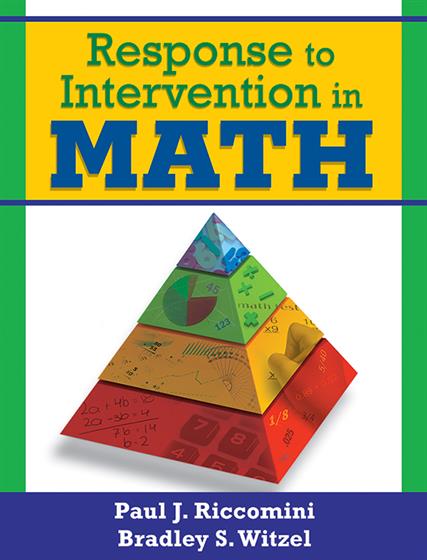
Hands-on, Practical Guidance for Educators
From math,
literacy, equity, multilingual learners, and SEL, to assessment, school counseling,
and education leadership, our books are research-based and authored by experts
on topics most relevant to what educators are facing today.
Response to Intervention in Math
Aligned with the NMAP final report and IES practice guide, this resource offers guidelines, intervention strategies, and case studies for designing and implementing RTI in math.
- Grade Level: PreK-12, Elementary, Secondary
- ISBN: 9781412966351
- Published By: Corwin
- Year: 2009
- Page Count: 168
- Publication date: December 04, 2012
Price: $39.95
For Instructors
When you select 'request review copy', you will be redirected to Sage Publishing (our parent site) to process your request.
Description
"The authors do a great job of blending ideas from mathematics education and the National Mathematics Panel Report with special education research. This is a great resource for those starting an RTI mathematics program."
—Russell Gersten, Professor Emeritus, University of Oregon
Director, Instructional Research Group
"Riccomini and Witzel have assembled a straightforward, well-organized, and systematically presented text that will be popular with inservice and preservice teachers alike."
—Kimberly Bright, Associate Professor of Educational Leadership and Special Education
Shippensburg University
Boost academic achievement for all students in your mathematics classroom!
Response to Intervention (RTI) is a system for assessment and instruction that has promising applications for teaching mathematics. This exciting new resource from Paul J. Riccomini and Bradley S. Witzel leads the way in applying RTI to mathematics instruction by offering guidelines for improving learning for all students, especially those who have learning disabilities or are struggling with mathematics content.
Drawing from evidence-based models, this guide begins with a comprehensive discussion of the RTI framework and the types of interventions appropriate within an RTI system for mathematics. The authors describe how the three tiers can be implemented in specific math areas and provide examples of RTI procedures illustrated in case studies. Aligned with the needs identified in the National Mathematics Advisory Panel final report and the IES practice guide, this book includes:
- Intervention strategies for specific mathematics areas, such as number sense, fractions, problem solving, and more
- Procedures for teaching math using systematic and explicit instruction as an approach to assessment, instructional planning, and evaluation
- Descriptions of essential components to consider when designing and implementing RTI in mathematics
- Guidelines for teaching math vocabulary
This timely resource provides tools and strategies that educators can immediately implement to help students achieve increased critical thinking skills and academic success.
Key features
- Each chapter begins with a brief description of how RTI can be implemented in a specific math area and presents multiple examples of RTI in various case studies
- Guidelines in each chapter address concerns and suggestions for multiple interventions related to the particular math area under discussion
Author(s)

Paul J. Riccomini

Bradley S. Witzel
Table of Contents
Preface
Acknowledgments
About the Authors
1. What Is RTI, and Why Is It Important?
Overview of RTI
Key Research Support for RTI and Mathematics
Summary
2. The RTI Process for Math: Getting Started
Selection of the RTI Team Members
Belief System
Common Models of Implementation
Assessment
Importance of the Core Mathematics Program
Summary
3. A Tiered Approach to More Effective Mathematics Instruction
Tier 1 Instruction and Curriculum
Tier 2 Intervention and Curriculum
Tier 3 Instruction and Curriculum
Summary
4. Mathematics Interventions Overview
Who Needs Intervention?
What Do I Teach for the Intervention?
Who Should Intervene?
Where?
How Long?
How Do I Organize My Curriculum?
What Types of Curricular Strategies Should Be Used for Tier 2 and Tier 3 Interventions?
Summary
5. Number Sense and Initial Math Skills
Assessments of Number Sense
Instructional Delivery of Number Sense
Curricular Elements of a Number Sense Intervention
In Context
Summary
6. Building Students' Proficiency With Whole Numbers
Importance of Proficiency in Whole Numbers
General Recommendations for Building Proficiency
Building Automatic Recall of Basic Facts With the Mastering Math Facts Program
Building Proficiency With Whole Numbers Through PALS Math
Summary
7. Fractions and Decimals
Fractions in the Standards
Assessment for Fractions and Decimals
When Are Calculators Sufficient?
Teaching the "What" With Fractions and Decimals
Teaching the "How to Compute" With Fractions and Decimals
Teaching Fluency With Fractions and Decimals
In Context
Summary
8. Teaching Problem Solving Strategically
Problem-Solving Programs
Summary
9. The Importance of Teaching Mathematical Vocabulary
The Importance of Teaching Mathematical Vocabulary
Instructional Activities to Promote Learning of Essential Mathematical Vocabulary
Assessing Students' Knowledge of Mathematical Vocabulary
Summary
10. Next Steps in the RTI Process
Professional Development
Reconsidering the Tier 1 Mathematics Curriculum
Why Is This Important for Educators Implementing an RTI Math Model?
An Alternative Approach: A Two Tier 1 Core Mathematics Program
Summary
References
Index
Reviews
"Does a great job of blending ideas from mathematics education and the National Mathematics Panel Report with special education research. A great resource for those starting an RTI mathematics program."Russell Gersten, Professor Emeritus, University of Oregon
Director, Instructional Research Group
"Finally, a scholarly and practical text to help administrators and teachers learn about and institute Response to Intervention in math! Riccomini and Witzel have assembled a straightforward, well-organized, and systematically presented text that will be popular with inservice and preservice teachers alike. It is easy to follow and not overwhelming. As a teacher educator, I am always searching for a text that has utility for later use, and this is such a book! This is one of those rare textbooks that teachers will use long after their course on effective instruction."Kimberly Bright, Associate Professor of Educational Leadership and Special Education
Shippensburg University
"The most comprehensive RTI book for mathematics that I have seen to date. The importance of choosing a research-based, effective, balanced core program cannot be overstated. By following the guidelines in this book, districts can make good, sound decisions."Shelly Kelly, Math Instructional Coach
Great Falls Public Schools, MT
"This book hits the right balance between being practical and research driven. It provides scientific, research-based instruction in mathematics, show that RTI can focus on more than just reading. It's a tour de force!"Kathy Durbin, Student Services Director
Lancaster County School District, SC
"This book is well written and well organized. I found the list of web sites for math programs and interventions of great use. I highly recommend Response to Intervention in Math."Joseph C. Ciechalski
Teaching Children Mathematics magazine, February 2011
For Instructors
When you select 'request review copy', you will be redirected to Sage Publishing (our parent site) to process your request.

